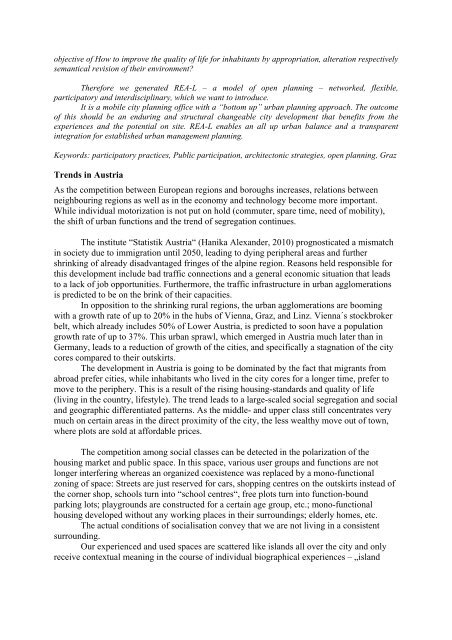HOW CAN PARTICIPATORY PRACTICES HAVE AN INPACT ON ...
HOW CAN PARTICIPATORY PRACTICES HAVE AN INPACT ON ...
HOW CAN PARTICIPATORY PRACTICES HAVE AN INPACT ON ...
Create successful ePaper yourself
Turn your PDF publications into a flip-book with our unique Google optimized e-Paper software.
objective of How to improve the quality of life for inhabitants by appropriation, alteration respectively<br />
semantical revision of their environment?<br />
Therefore we generated REA-L – a model of open planning – networked, flexible,<br />
participatory and interdisciplinary, which we want to introduce.<br />
It is a mobile city planning office with a “bottom up” urban planning approach. The outcome<br />
of this should be an enduring and structural changeable city development that benefits from the<br />
experiences and the potential on site. REA-L enables an all up urban balance and a transparent<br />
integration for established urban management planning.<br />
Keywords: participatory practices, Public participation, architectonic strategies, open planning, Graz<br />
Trends in Austria<br />
As the competition between European regions and boroughs increases, relations between<br />
neighbouring regions as well as in the economy and technology become more important.<br />
While individual motorization is not put on hold (commuter, spare time, need of mobility),<br />
the shift of urban functions and the trend of segregation continues.<br />
The institute “Statistik Austria“ (Hanika Alexander, 2010) prognosticated a mismatch<br />
in society due to immigration until 2050, leading to dying peripheral areas and further<br />
shrinking of already disadvantaged fringes of the alpine region. Reasons held responsible for<br />
this development include bad traffic connections and a general economic situation that leads<br />
to a lack of job opportunities. Furthermore, the traffic infrastructure in urban agglomerations<br />
is predicted to be on the brink of their capacities.<br />
In opposition to the shrinking rural regions, the urban agglomerations are booming<br />
with a growth rate of up to 20% in the hubs of Vienna, Graz, and Linz. Vienna´s stockbroker<br />
belt, which already includes 50% of Lower Austria, is predicted to soon have a population<br />
growth rate of up to 37%. This urban sprawl, which emerged in Austria much later than in<br />
Germany, leads to a reduction of growth of the cities, and specifically a stagnation of the city<br />
cores compared to their outskirts.<br />
The development in Austria is going to be dominated by the fact that migrants from<br />
abroad prefer cities, while inhabitants who lived in the city cores for a longer time, prefer to<br />
move to the periphery. This is a result of the rising housing-standards and quality of life<br />
(living in the country, lifestyle). The trend leads to a large-scaled social segregation and social<br />
and geographic differentiated patterns. As the middle- and upper class still concentrates very<br />
much on certain areas in the direct proximity of the city, the less wealthy move out of town,<br />
where plots are sold at affordable prices.<br />
The competition among social classes can be detected in the polarization of the<br />
housing market and public space. In this space, various user groups and functions are not<br />
longer interfering whereas an organized coexistence was replaced by a mono-functional<br />
zoning of space: Streets are just reserved for cars, shopping centres on the outskirts instead of<br />
the corner shop, schools turn into “school centres“, free plots turn into function-bound<br />
parking lots; playgrounds are constructed for a certain age group, etc.; mono-functional<br />
housing developed without any working places in their surroundings; elderly homes, etc.<br />
The actual conditions of socialisation convey that we are not living in a consistent<br />
surrounding.<br />
Our experienced and used spaces are scattered like islands all over the city and only<br />
receive contextual meaning in the course of individual biographical experiences – „island


